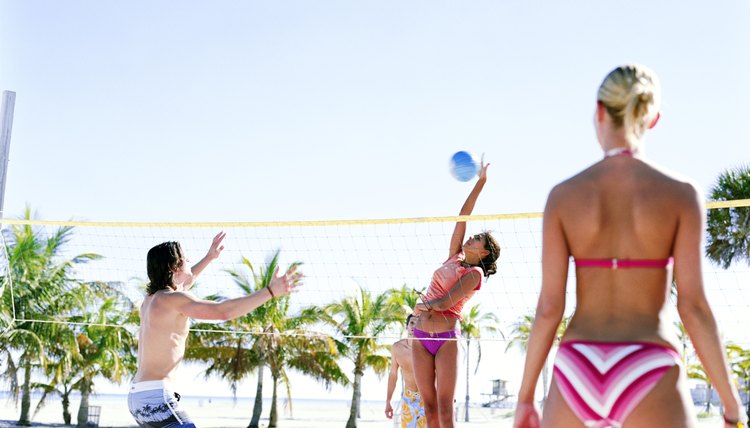Five Fitness Components for Volleyball

Fitness means different things to different people. For some, fitness means being able to run a long way or swim quickly while for others it is the ability to lift heavy weights or do the splits. Fitness is specific to the type of training you do and is the successful adaptation to a stress -- exercise being a type of stress. For a volleyball player to be effective, he needs to be able to demonstrate a wide range of fitness components.
Speed
Volleyball serves and smashes result in very fast ball speed, so players also need to be quick to get to the right position to return or pass the ball. Speed, both in terms of movement and reaction time, can be developed by performing sports-specific exercises such as multidirectional sprinting and using a uneven ball called a reaction ball which bounces unpredictably.
Agility
Agility is the ability to move your body quickly and efficiently into a position of your choosing. In volleyball this means getting into the right place at the right time to play a shot. Players often have to dodge, duck and dive to make successful plays and the better their agility, the better they will be able to do this. Training for agility involves performing activities that mimic the demands of the sport including jumping drills, playing shots from awkward positions and multidirectional running, jumping and sprinting.
Power
Power is your ability to generate strength at high speeds and is very important in volleyball. A volleyball net is 10 feet high, so players need leg power to be able to jump high enough to block and smash the ball during play. Hitting the ball with plenty of heat requires upper body power. Power is commonly developed by performing variations of the Olympic lifts, plyometrics or jumping exercises and by training with medicine balls.
Flexibility
Squatting or lunging down low to return a volleyball requires limber limbs -- properly called flexibility. Tight muscles do not stretch readily and, if stretched too quickly or too far, may become injured. Flexible muscles are more elastic and capable of greater ranges of movement. Flexibility is developed by stretching, particularly developmental stretches held for 30 seconds or longer. You can also increase your flexibility with proprioceptive neuromuscular facilitation or PNF stretching, which involves contracting a muscle hard before stretching it to increase flexibility more rapidly.
Endurance
Volleyball matches are usually played to the best of 21 points, and that can take some time if the teams are closely matched. To play continuously for an extended period of time requires good muscular, aerobic and mental endurance. Endurance is best developed by performing sub-maximal or lower-intensity activities for long periods of time. Examples include bodyweight squats, pushups, situps, jogging, cycling and extended volleyball practice periods.
References
Writer Bio
Patrick Dale is an experienced writer who has written for a plethora of international publications. A lecturer and trainer of trainers, he is a contributor to "Ultra-FIT" magazine and has been involved in fitness for more than 22 years. He authored the books "Military Fitness", "Live Long, Live Strong" and "No Gym? No Problem!" and served in the Royal Marines for five years.
